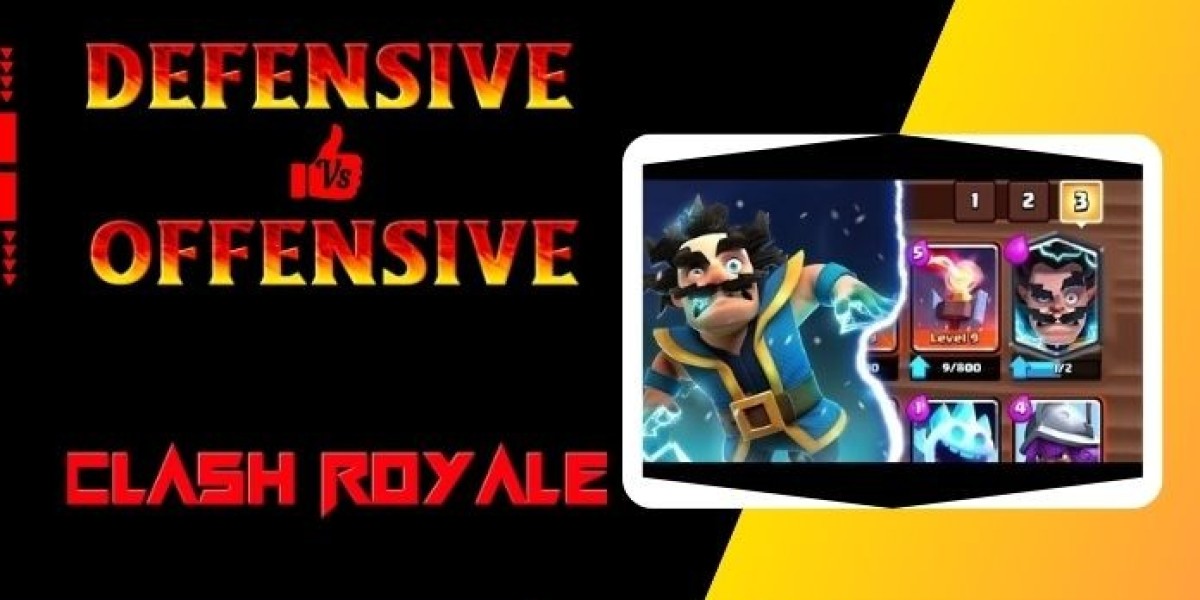Are you struggling to find the perfect balance between defence and offence in Clash Royale? Building a balanced deck in Clash Royale can be a challenging task.
Clash Royale is a game that expertly combines strategy, timing, and a dash of chance. A well-balanced deck gives you the freedom to counter your opponent's movements while launching your own planned strikes.
The key to success in Clash Royale is your ability to build a deck that can adapt to any circumstance. With a well-balanced deck, you may launch your own prepared attacks and countermaneuver your opponent's moves.
This is where the Clash Royale Deck Builder tool becomes invaluable. By utilizing this tool, you can experiment with different combinations and refine your strategy to perfection.
In order to balance offensive and defensive skills in their decks, players frequently have to choose from an endless number of methods and card combinations.
In this article, we'll explore the nuances of building a balanced Clash Royale deck that blends offensive and defensive strategies. Let's dive into the essentials of building a balanced Clash Royale deck.
Quick Overview of Deck Building
In Clash Royale, creating a deck involves more than just picking your best cards.
It involves creating a strategy that complements your style of play, whether that means emphasizing forceful attacks, strong defenses, or a combination of the two.
A well-balanced deck will give you the advantage in combat by adapting to various opponents and circumstances.
The Importance of Balance Decks in Clash Royale
Balancing defensive and offensive pieces in your deck guarantees that you can counter both aggressive and defensive playstyles from your opponents.
An imbalanced deck may flourish in one area while failing in the other, leaving you susceptible in a variety of circumstances.
The trick is to establish the appropriate balance so that you can remain versatile and adjust to any situation.
Understanding Defensive and Offensive Decks
Before diving into the intricacies of deck building, let's break down the core concepts of offensive and defensive strategies in Clash Royale.
What is a Defensive Deck?
An opponent's attacks are met with resistance and countered by a defensive deck. It emphasizes on utilizing cards that are excellent at dominating the battlefield and defending your towers. Among a defensive deck's essential components are:
- High Hit Points (HP) troops: Cards that absorb damage and attract opposing soldiers' attention include the Giant Skeleton and Golem.
- Strong Defensive Structures: Buildings such as the Inferno Tower and Tesla are designed to deal significant damage to enemy troops and tanks.
- Crowd Control: Spells and troops that can handle multiple enemies, like the Electro Dragon or Wizard, are essential for managing swarms.
- Efficient Elixir Management: Defensive decks often rely on low-cost cards to ensure they can afford to deploy defensive units frequently.
What is an Offensive Deck?
An aggressive deck, on the other hand, is intended to apply pressure and overwhelm your opponent. It relies on aggressive methods to do harm swiftly and effectively. The key qualities of an attacking deck are:
- High Damage Output: Cards like the Hog Rider and Balloon are used to deal immediate and significant damage to opponent towers.
- Fast Cycle: Offensive strategies frequently incorporate low-cost cards that allow you to swiftly cycle through your deck and maintain pressure.
- Win Conditions: Cards that are primarily designed to do damage to towers, such as the Royal Giant or X-Bow, are essential.
- Aggressive Spells: To make room for an aggressive approach, employ spells like Fireball and Rocket to destroy opponent troops and structures.
How to Build Balanced Decks in Clash Royale - A Step-by-Step Guide
Building a balanced deck entails incorporating aspects from both offensive and defensive methods.
This strategy ensures that you can manage a variety of circumstances and adapt to your opponent's playing style. Here are some steps to create a balanced deck: Let's get started.
Step 1: Choose a Win Condition
Your win condition is the primary method for doing damage to opponent towers. This might be a high-damage unit, a potent spell, or a mix of the two. Examples include:
- Hog Rider: Fast and reliable victory condition.
- Giant: A high-health tank that works well with support troops.
- Royal Giant: A long-range attacker capable of chipping away at fortifications.
Step 2: Add Support Troops
Support soldiers assist your victory condition in achieving its goal and doing maximum damage. Choose units that compliment your winning condition and are capable of dealing with a variety of threats. Examples include the following:
- Electro Wizard: Stuns and damages troops on the ground and in the air.
- Baby Dragon: Protects against splash damage and is effective against swarms.
- Minions: Minions are inexpensive and adaptable, capable of both offense and defense.
Step 3: Include Defensive Buildings
Defensive buildings help control the battlefield and counter enemy pushes. Choose buildings that can handle different types of threats. Examples include:
- Cannon: Effective against ground forces.
- Inferno Tower: High-health tanks are managed by Inferno Tower.
- Tesla: Adaptable and capable of fending off assaults from the air and the ground.
Step 4: Add Control Spells
Control spells may change the course of a fight and are quite versatile. Select spells that work well with your plan and may be used in a range of circumstances. As examples, consider:
- Fireball: Excellent for removing support troops, it deals high damage in a condensed area.
- Zap: Quick damage and stun; good for eliminating weaker enemies.
- Poison: Slows down adversaries and deals damage gradually, both of which are beneficial for commanding the battlefield.
Step 5: Test and Refine
Once you've built your deck, it's important to test it in battle and make adjustments based on your performance.
Pay attention to the following:
- Elixir Efficiency: Make sure your deck is reasonably priced and designed to facilitate easy elixir management.
- Versatility: Your deck should be flexible enough to accommodate diverse playstyles and tackle a range of threats.
- Synergy: Make sure your cards compliment one other's advantages and disadvantages and function effectively together.
FAQ's
Q. Can a Defensive Deck Be Effective in Higher Arenas?
Ans: Yes, but it should have enough offensive cards to successfully counter-push and take advantage of defensive moves.
Q. How Many Defensive Cards Should Be in a Balanced Deck?
Ans: Having 3 to 4 defensive cards is optimal since it gives you ample protection against different types of threats.
Q. What Types of Cards Are Best for Offence in a Balanced Deck?
Ans: Cards like the Hog Rider and Balloon, which have a high damage output and quick attack speed, are ideal for offensive strategies.
Q. What's More Important: Defence or Offence?
Ans: Both are essential, and a well-designed deck should successfully combine both.
Final Thoughts
Building a balanced Clash Royale deck requires a thoughtful blend of defensive and offensive strategies.
By understanding your strengths and weaknesses and continuously adapting to the evolving game landscape, you'll master the art of balance and achieve greater success on the battlefield.








